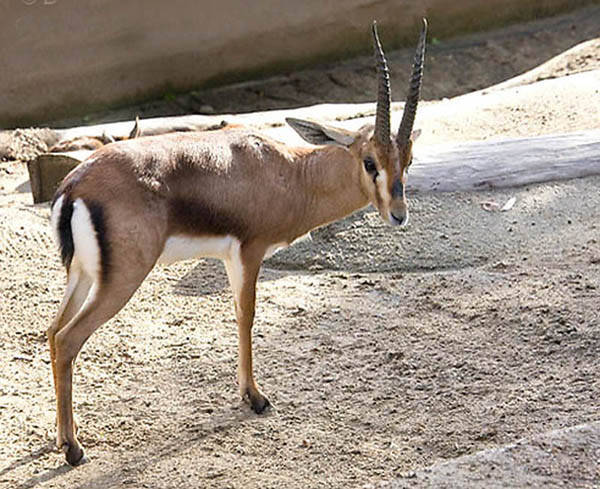Gazella cuvieri
IUCN
LCBasic Information
Scientific classification
- name:Gazella cuvieri
- Scientific Name:Gazella cuvieri,Cuvier's Gazelle, Knight's Gazelle
- Outline:Ungulata
- Family:Artiodactyla Bovidae Gazelle
Vital signs
- length:95-115cm
- Weight:15-35kg
- lifetime:12-15years
Feature
It is the darkest antelope in terms of fur color.
Distribution and Habitat
Gu's gazelle is found in northwestern Africa in Algeria, Morocco, Tunisia, and the western Sahara Desert.
Gu's gazelle lives at altitudes ranging from sea level to 3,300 meters, preferring sandy or rocky hills and plateaus. It inhabits semi-open Mediterranean forests with Aleppo pine (Pinus halpensis), red juniper (Juniperus phoenicea), holly oak (Quercus suber), and western cork oak (Quercus suber). It also lives in scrublands and grasslands along the Mediterranean coast. The species also lives in the northwestern Sahara Desert of Morocco and Algeria, occurring in arid mountainous and rocky desert areas, but avoiding areas with heavy snow. In the Tiaret region of Algeria, Gu's gazelle may graze in human-cultivated cereal fields.
Appearance
The body length of the Gullwing's gazelle is 95-115 cm, the body is 60-70 cm tall, the tail is 10-15 cm long; the weight is 15-35 kg. Both males and females have horns, although females are narrower and smoother. The horns are almost straight, only slightly curving outwards and backwards. The base of the male's middle horn is very rough. The horns of males are usually 25-37 cm long, and females are 20-30 cm. The length is between 25-33 cm.
This species has the darkest fur color of the antelopes. There is a broad black band on the ventral side from the front legs to the hind legs, separating the upper body from the lower abdomen. The upper body is dark brown from the head, back and legs, with white rump and abdomen, and has the typical characteristics of gazelles with a striped face with black stripes extending from the huge ears to the nose. A black line extends from the inner corner of the eye to the corner of the mouth, bordered by a wider whitish stripe at the top. Ther
Details
Cuvier's Gazelle (scientific name: Gazella cuvieri) is also known as Cuvier's Gazelle, Mountain Gazelle, Uvier's Gazelle, Cuviers Gazelle, and has no subspecies.

Cuvier's gazelles live in small groups of 3-5, sometimes up to 82 in large groups, these groups are composed of females and young antelopes, young males are excluded from the group and live in their own groups. Adult males are territorial. They all live in their own territories to fight against other males. The Gudjordje gazelle migrates down valleys at night and early morning, and moves through hills during the day. It visits water sources regularly and patrols its territory, marking its boundaries with urine, feces, and secretions from the preorbital glands. It is a herbivorous ruminant that is active in the morning and evening, foraging in open areas, and hides in the woods to rest in the afternoon. It is alert, good at jumping, and runs very fast. Males are territorial, marking their territory with urine and feces, and fierce fights occur between males during the breeding season.
The breeding season for Cuvier's gazelles is in early spring, with a gestation period of 160-170 days, and 1-2 calves per litter. Mature females will give birth to 2 litters per year. Mating occurs in early winter, and females are born in spring, just when the green grass grows after the rain. The gestation period is about 170 days. Most of the time, only one calf is born, but twins are not uncommon. If conditions are right, adult females can give birth to two litters in a year, but this is rare. Newborns hide in tall grass for the first few weeks of their lives to reduce the risk of being preyed on. In the wild, Cuvier's gazelles can live up to 12-15 years.

The main threats to the Gudjo's gazelle are overhunting and habitat degradation, mainly due to the conversion of forests to farmland and pastures for livestock and charcoal. Predation by dogs is also a threat to Gudjo's gazelle calves. Military operations by the Tunisian army, which have caused bombings and fires in the area, are also threats to the species.
Critical protected areas throughout the range of the Gus’s gazelle, including the Sahara, Algeria and Tunisia. Also of vital importance for reintroduction in the Dorsale Mountains. A wild population introduced from Morocco is kept in captivity in Almeria, Spain. The species is included in the CMS Sahelo-Saharan Antelope Action Plan. It is legally protected in all Tunisian range states. A project to reintroduce the species is also planned in Tunisia.
Listed in the IUCN Red List of Threatened Species 2017 ver3.1 - Vulnerable (VU).
Protect wild animals and stop eating game.
Maintaining ecological balance is everyone's responsibility!








